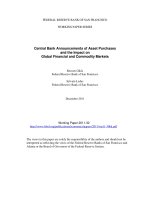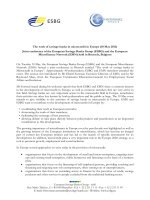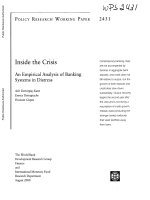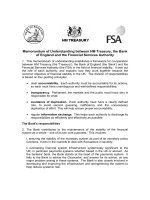Empirical analysis of board diversity and the financial performance deposit money banks in Nigeria
Bạn đang xem bản rút gọn của tài liệu. Xem và tải ngay bản đầy đủ của tài liệu tại đây (264 KB, 8 trang )
Accounting 5 (2019) 127–134
Contents lists available at GrowingScience
Accounting
homepage: www.GrowingScience.com/ac/ac.html
Empirical analysis of board diversity and the financial performance deposit money
banks in Nigeria
A.D. Adesanmia*, O.A. Sanyaolua, M.A. Isiakaa and O.A. Fadipea
aBells
University of Technology, Nigeria
CHRONICLE
Article history:
Received April 11 2019
Received in revised format April
24 2019
Accepted May 1 2019
Available online
May 3 2019
Keywords:
Board diversity
Board independence
Gender diversity
Financial performance
Deposit Money Banks
ABSTRACT
This study examined the effect of board diversity on the financial performance of deposit money
banks in Nigeria. The study also examined the relationship between board independence and
financial performance of deposit money banks in Nigeria. For the purpose of this study, the proxy
for financial performance is profit margin while the proxies for board diversity and board
independence are the ratio of female directors to total board size and ratio of non-executive
directors to total board size, respectively. The data for the study were sourced from the annual
reports of 10 listed deposit money banks in Nigeria from 2008 to 2017. The data were analyzed
using pooled Ordinary Least Square regression. The results show that the coefficient of board
diversity was positively signed and statistically significant at 5% (β=0.34, ρ=0.02); the
coefficient of board independence was positively signed and statistically significant at 5% (β=
0.11, ρ=0.02). The study concludes that both gender diversity and board independence positively
affect the financial performance of deposit money banks in Nigeria. Therefore, the study
recommends that deposit money banks should encourage appointment of qualified female
directors on the board. In addition, deposit money banks should ensure the independence of the
board by appointing independent non-executive director who are well experienced in bank
management.
© 2019 by the authors; licensee Growing Science, Canada
1. Introduction
Corporate governance is the system by which business corporations are directed and controlled. The
corporate governance structure specifies the distribution of the rights and the responsibilities among
different participants in the corporation, and spells out the rules and procedures for making decisions
on corporate affairs. Such participants include the board, managers, shareholders and other
stakeholders. Corporate governance also provides the structure through which the company objectives
are set, and the means of attaining those objectives and monitoring performance. The Board of
Directors is saddled with the responsibility of decision making on behalf of the shareholders. Agency
theorists argue that in order to protect the shareholders’ interests, the board of directors must assume
an effective oversight function. It is assumed that board performance of its monitoring duties is
influenced by the effectiveness of the board, which in turn is influenced by factors such as board
composition and quality, size of board, gender diversity, ethnic diversity and foreign directorship.
* Corresponding author.
E-mail address: (A. Adesanmi)
2019 Growing Science Ltd.
doi: 10.5267/j.ac.2019.5.001
128
Agency problem arises whenever managers have incentives to pursue their own interest (self-serving
behavior) at the expense of shareholders. Most studies on corporate governance focus on how to
effectively monitor the agents (resolving the conflict) against self- serving behavior in order to protect
shareholders interest. The board of directors is one of the most influential decision-making bodies. Its
responsibilities span from making key financial and strategic decisions, such as approving changes in
capital structure and mergers and acquisitions, to the difficult task of choosing the company’s top
executive leadership (Ferreira & Gyourko, 2014). The board is often noted as having four key
functions: monitoring and controlling managers, providing information and counsel to managers,
monitoring compliance with applicable laws and regulations, and linking the corporation to the external
environment (Mallin, 2004; Monks & Minow, 2004). Trend from the changes and reviews of corporate
governance codes reveals that there is a need to continuously investigate characteristics of boards that
will improve performance and reduce corporate failures and scandals. For example, the Security and
Exchange Commission (SEC) in 2003, put forward that, the financial sector attracted poor corporate
governance due to the fact that, only about 40% of quoted companies, including banks had recognized
codes of corporate governance in place. Consequently, in 2003, a Code of Best Practices on Corporate
Governance for public quoted companies was released by the Nigerian Securities and Exchange
Commission (SEC). However, in 2006, the consolidation of the banking industry necessitated a review
of the existing code for the Nigerian Banks. The new code therefore was developed to compliment the
earlier ones and enhance their effectiveness for the Nigerian banking industry. Compliance with the
provisions of the Code was mandatory. Again, in advancement of the banking reforms, the Central
Bank of Nigeria in May 2010, issued guidelines to address some corporate governance issues not
expressly addressed in the initial code of corporate governance, like the tenure of the Chief Executive
Officers (CEO).
The economic case for a diverse board is that board diversity causes a business to be more profitable
and creates value for shareholders. This argument implies that diverse directors are not perfect
substitutes with identical ability and talents but diverse directors have unique characteristics that create
additional value. Since the banking sector is the bedrock of any economy, there is need to focus
attention on the board composition and diversity to guard against the failure of this sector of the
economy. This study has great significance due to the fact that few studies of this nature have been
carried out in African countries and other less developing countries. Boards of directors have been
largely blamed for decrease in shareholder’s wealth and corporate failure. They have been blamed for
the fraud cases that had resulted to the failure of major corporations, such as Enron, WorldCom and
Global Crossing. In Nigeria, a series of widely-publicized cases of accounting improprieties have been
recorded. Examples include the case of Wema Bank, Finbank and Spring Bank, and more recently
Skye Bank.
Some of the reasons stated for these corporate failures are the lack of vigilant oversight functions by
the board of directors, the board relinquishing control to corporate managers who pursue their own
self-interests and the board being remiss in its accountability to stakeholders. As a result, various
corporate governance reforms have specifically emphasized on appropriate changes to be made to the
board of directors in terms of its composition, structure and ownership configuration and constituting
strategic resources to the organization. Various studies on corporate governance have mainly focused
on the size of the board as well as composition in terms of executive and non-executive. Most of these
studies have failed to examine how is the diversity of the board, in terms of gender of the directors,
affect the performance of firms.
A. Adesanmi et al./Accounting 5 (2019)
129
2. Literature Review and Theoretical Framework
2.1 Theoretical Review
The relevant theoretical perspectives that relates to the focus of this study include the popular Agency
Theory, the Stakeholder’s theory and the Resource Dependency theory. Each of these are discussed in
this section.
a) Agency Theory
Agency theory is based on the fact that many corporate managers are not owners but agents of owners,
contracted to manage the company on their behalf (Ujunwa et al., 2012). According to Fama and Jensen
(1983), the board of directors is one of several important mechanisms that control and monitor
managers and plays a vital role in the managerial policies of the companies. The board of directors
aims to solve agency problems between managers and shareholders (Dang et al., 2013). Based on this
theory, the presence of women and foreign directors will increase the board’s effectiveness and firm
performance. The basic premise is that diversity may lessen the tendency for boards to engage in
groupthink (Ujunwa et al., 2012). Agency theorists also indicate that having women, ethnic minorities,
and foreigners as external stakeholders may bring fresh solutions to complex issues (Francoeur et al.,
2007). For instance, female directors might be more active in monitoring and controlling managers by
asking more questions and bringing different perspectives to the boardroom (Dang et al., 2013).
Furthermore, diversity will increase board independence because people with a different gender,
ethnicity, or cultural background might ask questions that would not come from directors with
traditional backgrounds (Carter et al., 2008, 2010). Hence, diverse boards will improve firm
performance by increasing board independence.
b) Stakeholder’s theory
The stakeholders’ theory provides that the firm is a system of stakeholders operating within the larger
system of the host society that provides the necessary legal and market infrastructure for the firm's
activities. The purpose of the firm is to create wealth or value for its stakeholders by converting their
stakes into goods and services. This view is supported by Blair (1995) who proposes that the goal of
directors and management should be maximizing total wealth creation of the firm. The key to achieving
this is to enhance the voice of and provide ownership-like incentives to those participants in the firm
who contribute or control critical, specialized inputs (firm specific human capital) and to align the
interests of these critical stakeholders with the interests of outside, passive shareholders. Sundaram and
Inkpen (2004) also suggest that stakeholder theory is appropriate for analysing whether management
gives more attention to the interest of some stakeholders relative to others.
c) Resource Dependency theory
Resource dependence theory (RDT) studies how external resources of company affect its behavior and
strategy. Company should have control of its critical resources so that it is not dependent on other
parties. This theory is related to the contact role of board of director in which companies seek to manage
external dependency by forming ownership ties and board connections (Nicholson & Kiel, 2007;
Thomsen & Conyon, 2012). In a review by Hillman et al. (2002), the authors identified four primary
benefits for the external linkages which are: provision of specific resources such as expertise
information or advice from individuals with experience in a variety of areas, creation of channels of
communication to the firm; provision of commitments of support from important organizations in
external environment; creation of legitimacy for the firm. Board ties and connections provide
opportunities and access to valuable resources for companies. Hillman et al. (2002) state that different
types of directors provide different beneficial resources to the company, such as: advice, legitimacy
and outside information. Hence, a more diverse board will provide more variations and more valuable
resources, which lead to better firm performance. Among other corporate governance theories, resource
dependence theory provides the most convincing theoretical basis for board diversity and its effect on
130
firm performance. Concerning with this, Carter et al. (2010) point out that gender and ethnic diversity
in the board provide unique information sets for management to make better decision. Diverse directors
give access to important constituencies in external environments. Moreover, board diversity sends
positive signals to the market and diverse directors bring various perspectives and non-traditional
approaches to problem solving. To support that, Ruigrok et al. (2007) add that the increasing
internationalization of business leads to a higher demand for directors who possess necessary
knowledge and contacts in foreign markets. In this case, foreign director might be qualified and be able
to link the company to different contexts of the countries in which it operates. Likewise, with the
increasing involvement of women in business world, the importance of female representation on
corporate boards is also rising (Burke & Mattis, 2000; Ruigrok et al., 2007; Salloum et al., 2019).
2.2 Empirical review
Otuya et al. (2017) examined the effect of banks’ board globalizing on financial performance of quoted
banks in Nigeria. The study made use of secondary data, which were obtained from the annual reports
of ten banks for the years 2011- 2015. The study made use of the following variables: Board of
Directors, Board Globalizing, Financial Performance, Asset Growth and Bank Riskiness. The study
adopted the ordinary least square (OLS) regression as the basic techniques of data analysis. The authors
found that foreign board membership, asset growth and institutional ownership have a significant
positive relationship with financial performance of banks.
Matanda et al. (2015) examined the relationship between corporate board independence and the
performance of commercial banks in Kenya for the period spanning 2001 to 2013. The study made use
of Return on assets, Return on Equity and Tobin Q Ratio. A panel data regression analysis was used in
analyzing the variables under consideration. The study recommended that if commercial banks in
Kenya are to improve their performance they should direct their efforts towards other variables other
than board composition. Garba and Abubakar (2014) examined the relationship between board
diversity and financial performance of insurance companies in Nigeria. The study selected 12 listed
insurance companies using non-probability sampling method in the form of availability sampling
technique for a period of 6 years (2004 to 2009). The authors used descriptive statistics and panel
regression method to analyze the data collected for the purpose of the study. The study revealed that
gender diversity and foreign directors have a positive influence on insurance companies’ performance.
Saleh (2016) investigated the effect of the board of directors’ attributes on the financial performance
of deposit money banks in Nigeria during the period 2009-2014. The study adopted panel multiple
regression technique of data analysis. The study recommended that in order for the Security and
Exchange Commission and Central Bank of Nigeria to improve performance in deposit money banks,
good corporate governance practices must be implemented, this should include improving board
attributes, especially the functional background of the directors. Uadiale (2010) examined the impact
of board structure on corporate financial performance in Nigeria. The study made use of companies
listed on the floor of the Nigerian Stock Exchange. Board structure, Corporate financial performance,
Board ownership and Duality are the variables used. Ordinary Least Squares (OLS) regression was
used to estimate the relationship between corporate performance measures and board structure of the
Nigerian firms. The study suggested that large board size should be encouraged and the composition
of outside directors as members of the board should be sustained and improved upon to enhance
corporate financial performance. Bebeji et al. (2015) analyzed the effects of board size and board
composition on the performance of Nigerian banks. Board size, board composition and financial
performance are the variables employed to achieve the study objective. Regression analysis and
Correlation matrix was used to analyze the financial statements of five banks as a sample for a period
of nine years. The study concluded that banks should have adequate board size to the scale and
complexity of the organization’s operations and be composed in such a way as to ensure diversity of
experience without compromising independence, compatibility, integrity and availability of members
131
A. Adesanmi et al./Accounting 5 (2019)
to attend meetings. Agyei and Owusu (2014) explored the relationship between ownership structure
and corporate governance and capital structure of some listed manufacturing companies on Ghana
Stock Exchange. The study covered the period 2007 to 2011. Descriptive analysis, correlation analysis
and multivariate regression technique were the tool of analysis. The study discovered that Board Size,
Board Composition, Institutional and Managerial shareholding are positively and significantly
correlated with leverage ratio, whereas CEO/Chair duality has a negative impact. Moscu (2013)
investigated the relationship between Firm Performance and Board Characteristics in Romania. This
study analyzed 62 firms listed on the Bucharest Stock Exchange in 2010. The study stated that an
increase in the size of the board of management be encouraged as it leads to increased profitability,
diversity and information in the company.
Khan and Awan (2012) explored the effect of board composition on firm’s performance, specifically a
case of Pakistani listed companies. A sample of 91 listed companies at Karachi stock exchange was
examined. The independent sample t-test and group Statistics were used as the most appropriate
techniques for data Analysis. The study recommended that companies should have independent
directors in their board composition which will show greater firm performance. Ujunwa et al. (2012)
investigated the impact of corporate board diversity on the financial performance of Nigerian quoted
firms. The scope covered from 1991-2008. Least Square Regression was used to examine the impact
of board diversity on firm performance. The study suggested that foreign board members would provide
a firm with better qualified candidates who have broader industry experience. Additionally, the
presence of women on the board could be perceived by shareholders as a sign of impending significant
change.
3. Methodology
This study modelled performance as a function of gender diversity, board diversity, board composition
and board independence. The model is implicitly specified as:
PERF=f (gender diversity, board size, board compensation, board independence)
(1)
This is stated in econometric form as follows:
PMi,t=β0 +β1BCOMit + β2BSit + β3BINDit +β4BGDit+µit
(2)
where
PM=Profit Margin
BCOM=board compensation
BS= Board size
BIND=Board Independence
BGD= Board gender diversity
i=number of banks
t=period/time
µ=error term
β0,β1,β2, β3, β4 are coefficient of explanatory variables
4. Result and Discussion
The panel regression result shows the estimate of the effect of gender diversity on financial performance
of the sampled banks. The result shows that the coefficient of multiple determination R2= 0.58,
indicating that about 58% of the total variation in the dependent variable (profit margin) is explained
by the independent variables (Board gender diversity, Board independence, Board size and Board
compensation).
132
Table 1
The results of the regression model
Variable
LCOM
BS
BIND
BGD
C
Coefficient
Std. Error
0.005530
0.006473
0.001647
0.002244
0.110587
0.044965
0.033609
0.095155
0.046328
0.089794
Effects Specification
Cross-section fixed (dummy variables)
Weighted Statistics
R-squared
0.581619
Adjusted R-squared
0.518376
F-statistic
9.196500 Durbin-Watson stat
Prob(F-statistic)
0.000000
t-Statistic
0.854384
0.733967
2.459415
0.353206
0.515944
Prob.
0.0053
0.0450
0.0159
0.0248
0.6072
1.996157
Sources: Author’s computation 2018
The F-statistics value is statistically significant at 5% level, indicating that the model is significant. The
Durbin-Watson of 1.996 indicates that the result is free from serial auto correlation problem. The
coefficient of board gender diversity is 0.034 with p-value of 0.0248, which is less than critical value
of 0.05 for board gender diversity, this is statistically significant and it indicates that there is positive
relationship between board gender diversity and financial performance in the sampled banks in Nigeria.
This suggests that a unit increase in the proportion of female on the board will lead to 3% increase in
the financial performance of the selected banks. The result also shows that coefficient of board
independence is 0.11 with a p-value of 0.0159, which is less than critical value of 0.05 for board
independence, which indicates that there is positive and significant relationship between board
independence and financial performance of sampled banks. This shows that a unit increase in board
independence will result to 11% increase in financial performance of the sampled bank. Furthermore,
the result also revealed that the coefficient of board size is 0.001647 and p-value of 0.0450 which is
less than critical value of 0.05 of board size, this indicate that there is a positive and significant
relationship between the board size and financial performance. More so, the result also reveal that there
is a positive and significant relationship between board compensation and financial performance with
0.01 as a coefficient of board compensation and 0.0053 as the associated p-value.
The study finds that there was a positive relationship between board gender diversity and financial
performance. This implies that the presence of female directors on the board of banks has positive effect
on the financial performance of banks. This can be likened to the role women play in home front. The
role of women in the family cannot be over-emphasized for the success of the family as they are good
managers of resources and make decisions that effect on the family positively. The finding of this study
corroborates this assertion. This finding is similar to the conclusion drawn by Garba and Abubakar
(2014), Ujunwa et al. (2012) and Ruuska (2017).The study also finds out that there is a positive and
significant relationship between board independence and financial performance of selected banks. This
means that upholding good governance improves financial performance. This is consistent with the
conclusion drawn by Otuya et al. (2017), Saleh (2016), Khan and Awan (2012).
Furthermore, the result of this study shows a positive and significant relationship between board size
and financial performance. This signifies that increase in board size will lead to increase in profit
margin. This means the number of directors on the board has a synergistic effect on the decision making
of the board, which eventually leads to better financial performance of the selected banks in Nigeria.
This finding is similar to Uadiale (2010), Bebeji et al. (2015), Moscu,(2013), Darmadi (2013). In
addition, the result indicates that board compensation had positive and significant relationship with
financial performance. When directors are motivated, this has a great impact on financial performance
A. Adesanmi et al./Accounting 5 (2019)
133
because it is the board members that will formulate policies and make decisions which will have great
impact on the overall financial performance of the organization.
5. Concluding Remarks and Recommendation
The study investigated the effect of board diversity on financial performance of deposit money banks
in Nigeria. The study has found that there was a positive relationship between board gender diversity
and financial performance. This implies that the presence of female directors on the board of banks has
positive effect on the financial performance of banks. This can be likened to the role women play in
home front. The role of women in the family cannot be over-emphasized for the success of the family
as they are good managers of resources and make decisions that effect on the family positively. Based
on the findings and conclusion from the study, in order to have a good corporate governance in the
banking sector, the current study recommends that more female representation on the board should be
mandated since it has been proved statistically that gender diversity will increase the performance of
deposit money banks since women are good managers of resources and make decisions that effect on
the family positively. In addition, the independence of board should also be reviewed. It is
recommended that appropriate combination of executive and non-executive directors should be
maintained so that it can influence positively on the financial performance of deposit money banks in
Nigeria.
References
Agyei, A., & Owusu, A. R. (2014). The effect of ownership structure and corporate governance on
capital structure of Ghanaian listed manufacturing companies. International Journal of Academic
Research in Accounting, Finance and Management Sciences, 4(1), 109-118.
Bebeji, A., Mohammed, A., & Tanko, M. (2015). The effect of board size and composition on the
financial performance of banks in Nigeria. African Journal of Business Management, 9(16), 590598.
Blair, R. J. R. (1995). A cognitive developmental approach to morality: Investigating the
psychopath. Cognition, 57(1), 1-29.
Burke, R. J., & Mattis, M. C. (Eds.). (2013). Women on corporate boards of directors: International
challenges and opportunities (Vol. 14). Springer Science & Business Media.
Carter, D., D'Souza, F. P., Simkins, B. J., & Simpson, W. G. (2008). The diversity of corporate board
committees and financial performance. Available at SSRN 1106698..
Carter, D. A., D'Souza, F., Simkins, B. J., & Simpson, W. G. (2010). The gender and ethnic diversity
of US boards and board committees and firm financial performance. Corporate Governance: An
International Review, 18(5), 396-414.
Dang, R., Nguyen, D. K., & Vo, L. C. (2013). Women on corporate boards and firm performance: A
comparative study. Retrieved December, 11, 2013.
Darmadi, S. (2013). Do women in top management affect firm performance? Evidence from
Indonesia. Corporate Governance: The international journal of business in society, 13(3), 288-304.
Fama, E. F., & Jensen, M. C. (1983). Separation of ownership and control. The journal of law and
Economics, 26(2), 301-325.
Ferreira, F., & Gyourko, J. (2014). Does gender matter for political leadership? The case of US
mayors. Journal of Public Economics, 112, 24-39.
Francoeur, C., Labelle, R., & Sinclair-Desgagné, B. (2008). Gender diversity in corporate governance
and top management. Journal of business ethics, 81(1), 83-95.
Garba, T., & Abubakar, B.A. (2014). Corporate board diversity and financial performance of insurance
companies in Nigeria. Asian Economic and Financial Review, 4(2), 257-277
Sundaram, A. K., & Inkpen, A. C. (2004). The corporate objective revisited. Organization
science, 15(3), 350-363.
Ujunwa, A. (2012). Board characteristics and the financial performance of Nigerian quoted
firms. Corporate Governance: The international journal of business in society, 12(5), 656-674.
134
Hillman, A. J., Cannella Jr, A. A., & Harris, I. C. (2002). Women and racial minorities in the
boardroom: how do directors differ?. Journal of management, 28(6), 747-763.
Khan, A., & Awan, S. H. (2012). Effect of board composition on firm’s performance: A case of
Pakistani listed companies. Interdisciplinary Journal of Contemporary Research in Business, 3(10),
853-863.
Mallin, C.A. (2004). Corporate Governance. Oxford University Press, Oxford.
Matanda, J.W., Luke, O., & Lishernga Lisiolo, J. (2015). Relationship between board composition and
performance of commercial banks in Kenya. Research Journal of Finance and Accounting, 6(14),
78-88.
Monks, R., & Minow, N. (2004). Corporate governance, vol. 3. Blackwell Publishing, Malden, MA.
Moscu, R. G. (2013). The relationship between firm performance and board characteristics in
Romania. International Journal of academic research in economics and management
sciences, 2(1), 167.
Nicholson, G. J., & Kiel, G. C. (2007). Can directors impact performance? A case‐based test of three
theories of corporate governance. Corporate Governance: An International Review, 15(4), 585-608.
Otuya, S., Donwa, P. A., & Egware, N. (2017). Earnings management and quality of corporate
governance in Nigeria: A review of executive compensation and audit committee
characteristics. Journal of Accounting and Financial Management, 3(3), 2017.
Ruigrok, W., Amann, W., & Wagner, H. (2007). The internationalization-performance relationship at
Swiss firms: A test of the S-shape and extreme degrees of internationalization. Management
International Review, 47(3), 349-368.
Sunday, O., & Godwin, O. (2017). Effects of Board Globalizing on Financial Performance of Banks
in Nigeria. International Journal of Academic Research in Accounting, Finance and Management
Sciences, 7(4), 1-10.
Saleh, M. (2016). Effect of Board of Directors' Attributes on the Financial Performance of Listed
Deposit Money Banks in Nigeria. www.iiste.org. 15.
Salloum, S. A., Al-Emran, M., Shaalan, K., & Tarhini, A. (2019). Factors affecting the E-learning
acceptance: A case study from UAE. Education and Information Technologies, 24(1), 509-530.
Thomsen, S., & Conyon, M. (2012). Corporate governance: Mechanisms and systems. McGraw Hill.
Ujunwa, A., Okoyeuzu, C., & Nwakoby, I. (2012). Corporate board diversity and firm performance:
Evidence from Nigeria. Revista de Management Comparat International, 13(4), 605.
Uadiale, O. M. (2010). The impact of board structure on corporate financial performance in
Nigeria. International Journal of Business and Management, 5(10), 155.
© 2019 by the authors; licensee Growing Science, Canada. This is an open access
article distributed under the terms and conditions of the Creative Commons Attribution
(CC-BY) license ( />









